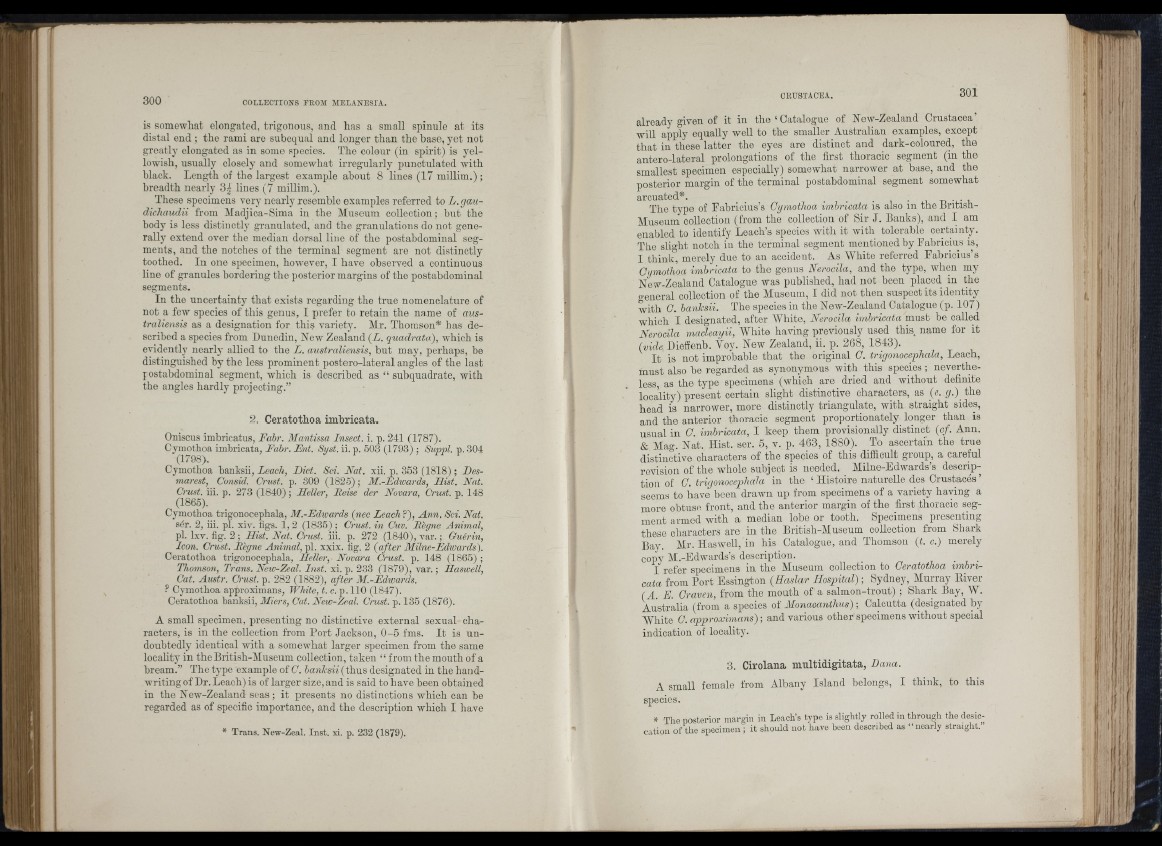
r ï
300 COLLECTIONS FEOM MELANESIA.
is somewhat elongated, trigonous, and has a small spinule at its
distal end ; the rami aro subeqnal and longer than the base, yet not
greatly elongated as in some species. Tho colour (in spirit) is yellowish,
usually closely and somewhat irregularly punctulated with
black. Length of the largest example about 8 lines (17 millim.) ;
breadth nearly 3^ lines (7 millim.).
These specimens very nearly resemble examples referred to L.gau-
dicliaudii from Aladjica-Sima in the Alusenm collection; bnt the
body is less distinctly granulated, and the granulations do not generally
extend over the median dorsal line of the postahdominal segments,
and the notches of the terminal segment are not distinctly
toothed. In one specimen, however, 1 have observed a continuous
line of granules bordering the posterior margins of the postahdominal
segments.
In the uncertainty that exists regarding the true nomenclature of
not a few species of this genus, I prefer to retain the name of australiensis
as a designation for this variety. Air. Thomson* has described
a species from Dunedin, New Zealand (L. quadrata), which is
evidently nearly allied to the L. australiensis, but may, perhaps, be
distinguished by the less prominent postero-lateral angles of the last
postahdominal segment, which is described as “ subquadrate, with
the angles hardly projecting.”
2. Ceratothoa imbricata.
Oniscus imbricatus, Fahr. Mantissa Insect, i. p. 241 (1787).
Cymothoa imbricata, Fahr. Ent. Syst. ii. p. 503 (1793) ; Suppl. p. 304
Cymothoa banksii, Leach, Diet. Sci. Nat. xii. p. 353 (1818) ; Des-
marest, Consid. Crust, p. 309 (1825) ; M.-Edioards, Hist. Nat.
Cmst. iii. p. 273 (1840) ; Heller, Reise der Novara, Crust, p. 148
(1865).
Cymothoa trigonocepbala, M.-Edwards (nec Leach ?), Ann. Sci. Nat.
sér. 2, iii. pi. XÎA-. iigs. 1, 2 (1835) ; Crust, in Guv. Règne Animal,
pi. Ixv. fig. 2 ; Hist. Nat. Crust, iii. p. 272 (1840), var. ; Guerin,
Icon. Crust. Règne Animal, pi. xxix. tig, 2 (after Milne-Edxoards).
Ceratothoa trigonocepbala, Heller, Novara Crust, p. 148 (1865) ;
Thomson, Trans. New-Zeal. Inst. xi. p. 233 (1879), var. ; Hasivell,
Cat. Austr. Crust, p. 282 (1882), after M.-Edwards.
? Cymothoa approximans, White, t. c. p. 110 (1847).
Ceratothoa hanksii, Miers, Cut. New-Zeal. Crust, p. 135 (1876).
A small specimen, presenting no distinctive external sexual characters,
is in the collection from Port Jackson, 0 -5 fms. I t is undoubtedly
identical with a somewhat larger specimen from the same
locahty in the British-Aluseum collection, taken “ from the mouth of a
bream.” The type example of C. hanksii (thus designated in the handwriting
of Dr. Leach) is of larger size, and is said to have been obtained
in the New-Zealand seas; it presents no distinctions which can he
regarded as of specific importance, and the description which I have
CRUSTACEA. 301
already given of it in tho ‘ Catalogue of New-Zealand Crustacea’
will apply equally well to the smaller Australian examples, except
th at in these latter the eyes are distinct and dark-coloured, the
antero-lateral prolongations of the first thoracic segment (in the
smallest specimen especially) somewhat narrower at base, and the
posterior margin of the terminal postahdominal segment somewhat
arcuated*. _ _ • -n -i.- n
The type of Fabricius’s Cymothoa imbricata is also in the Bntisn-
Alusemn collection (from the collection of Sir J. Banks), and I am
enabled to identify Leach’s species with it ivith tolerable certainty.
The slight notch in the terminal segment mentioned by Fabricius is,
I think, merely due to an accident. As White referred Fabricius’s
Cymothoa imbricata to the genus Nerocila, and the typo, Avhen my
New-Zealand Catalogue was published, had not been placed in the
general collection of the Aluseum, I did not then suspect its identity
Avith 0. hanksii. The species in the New-Zealand Catalogue (p. 107)
which I designated, after AVhite, Nerocila imbricata must be called
Nerocila macleayii, AYhite having previously used this name tor it
(vide Dieffenb. Yoy. New Zealand, ii. p. 268, 1843).
I t is not improbable that the original C. trigonocephala, Leach,
must also be regarded as synonymous with this species ; nevertheless,
as the type specimens (Avhich are dried and without definite
locality) present certain slight distinctive characters, as Q. g.)_ the
head is narrower, more distinctly triangulate, with straight sides,
and the anterior thoracic segment proportionately longer than is
usual in G. imhricata, I keep them provisionally distinct (cf. Ann.
& Alag. Nat. Hist. ser. 5, v. p. 463, 1880). To ascertain the true
distinctive characters of the species of this difficult group, a careful
revision of the whole subject is needed. Alilne-Edwards’s description
of C. trigonocephala in the ‘ Histoire natureUe des Crustacés ’
seems to have been drawn up from specimens of a variety having a
more obtuse front, and the anterior margin of the first thoracic segment
armed Avith a median lobe or tooth. Specimens presenting
these characters are in the British-Aluseum collection from Shark
Bay. Air. HasAvell, in his Catalogue, and Thomson (t. c.) merely
copV Al.-EdAvards’s description.
I refer specimens in the Aluseum collection to Geratothoa imbrv-
cata from Port Essington (Haslar Hospital) ; Sydney, Alurray Eiver
(A. E. Craven, from the mouth of a salmon-trout) ; Shark Bay, W.
Australia (from a species of Monacanthus) ; Calcutta (designated by
White 0. approximans) ; and various other specimens without special
indication of locality.
3. Cirolana multidigitata, Dana.
A small female from Albany Island belongs, I think, to this
species.
The posterior margin in Leach’s type is slightly rolled in through the desiccation
of the specimen ; it should not have been described as “ nearly straight.
I J
! :
.if
-, !
I ill
Î J